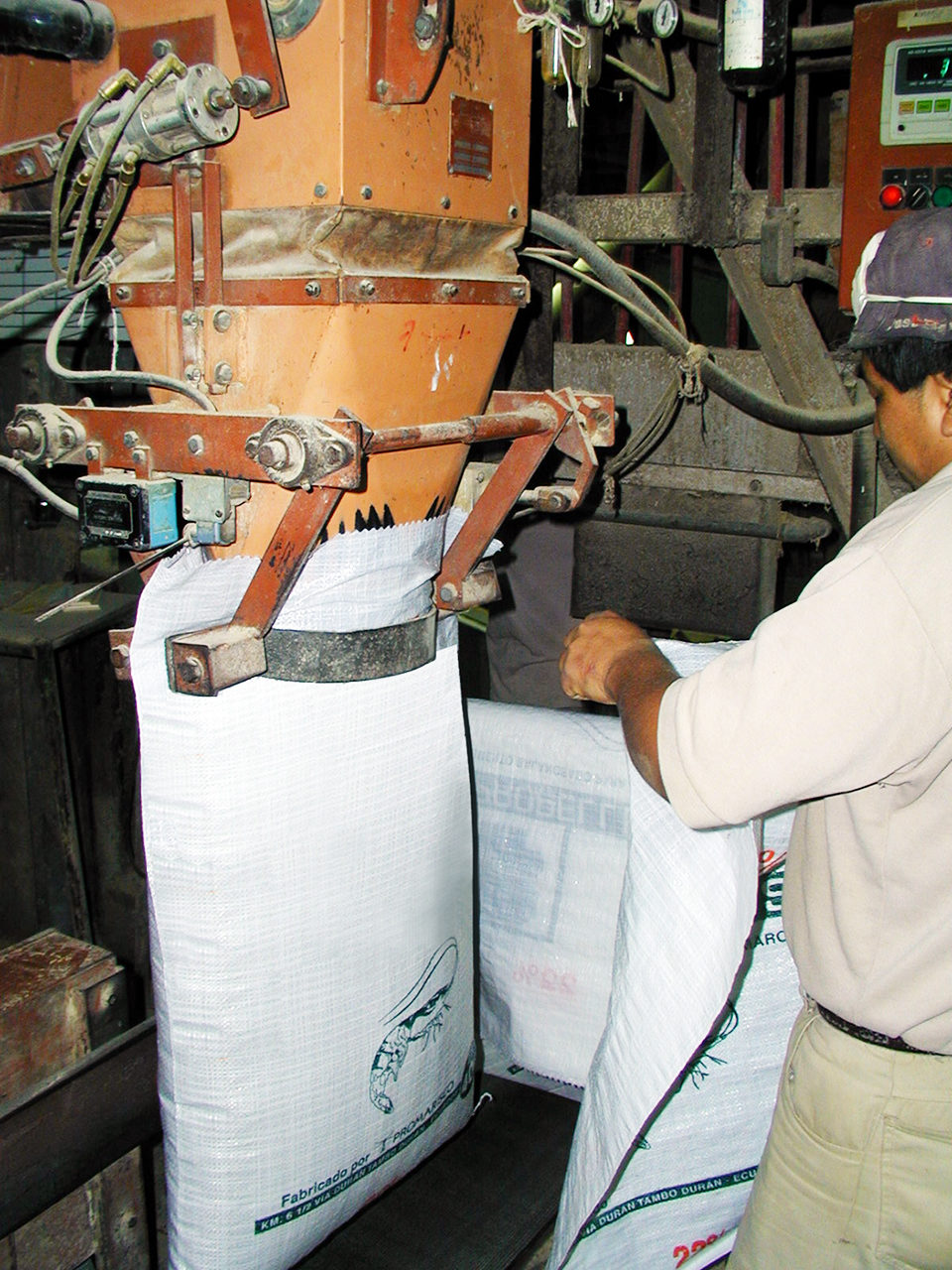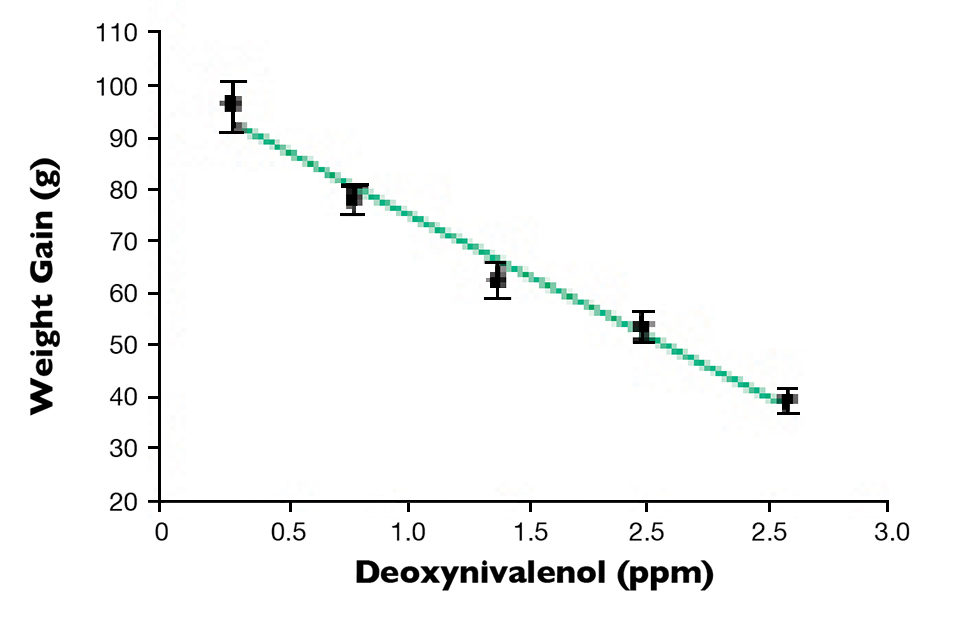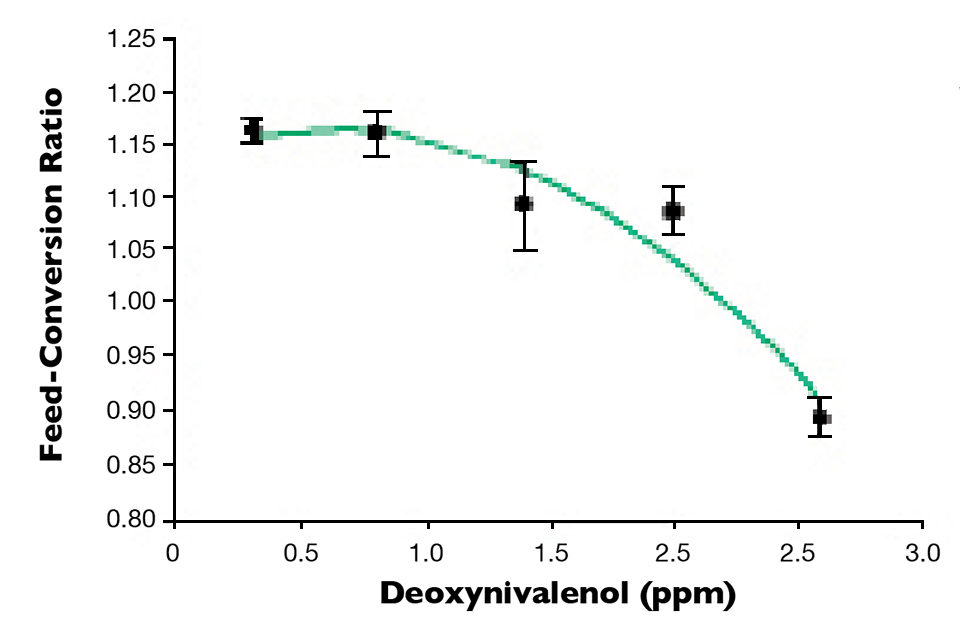Aquafeed manufacturers must implement risk management strategies

Considerable changes in the formulation of commercial salmonid feeds have occurred in the past two decades. Substantial efforts have been invested in the development of more cost-effective feeds containing lower amounts of fishmeal and higher levels of economical agricultural commodities.
It has been shown that highly nutritious and cost-effective feeds for salmonids can be formulated using high levels of feedstuffs of plant origin. However, concerns have been expressed that the greater reliance on ingredients of plant origin may increase the risk of exposing these animals to mycotoxins.
Mycotoxins
Mycotoxins are structurally diverse, potentially toxic metabolites produced by filamentous fungi. Fungal growth on crops can occur in the field before harvest, during harvest or after harvest during transport and storage of commodities. Environmental factors such as moisture and temperature play important roles in the development of the conditions required for fungal growth and subsequent mycotoxin production.
Mycotoxins have attracted worldwide attention because of the significant economic losses associated with their impacts on human health, animal productivity and feed and agricultural industries. It is estimated that approximately 25 percent of the world’s crop production is contaminated to some extent by mycotoxins. Financial losses due to the loss of crops, mitigation efforts and mycotoxicoses in agricultural animals have been estimated as high as several hundred million dollars each year.
Consumption of mycotoxin-contaminated feeds by livestock, poultry and fish results in a variety of symptoms that range from decreased production efficiency to mortality. Unspecific symptoms associated with mycotoxin exposure make diagnosis difficult. Sensitivity to mycotoxins varies greatly between species and depends on several factors, including age, gender, and nutrition and health status prior to exposure.
Mycotoxins that have the potential to affect animal health and performance are produced primarily by three fungal species: Aspergillus, Penicillium and Fusarium. Although several hundred mycotoxins exist, those of most concern to the animal feed industry are the Aspergillus and Penicillium mycotoxins aflatoxin B1 and ochratoxin A, and the Fusarium mycotoxins, zearalenone, fumonisin B1 and the trichothecenes such as deoxynivalenol.
Fusarium mycotoxins in aquaculture
The Fusarium mycotoxins constitute one of the largest and most economically significant classes of mycotoxins worldwide. Relative to terrestrial species, comparatively few studies have examined the impacts of Fusarium mycotoxins on fish health and performance.
Furthermore, much of the research to date has focused on omnivorous warmwater species, since feeds for these species are commonly formulated to contain high levels of cereal grains and other plant ingredients. Given the widespread distribution of these mycotoxins and changes in the dietary composition of salmonid feeds, information regarding their effects on different fish species is critical.
Fumonisin B1
The fumonisins are found predominantly in corn-based ingredients. Fumonisin B1 (FB1) is the most widely studied and most prevalent, accounting for approximately 70% of the total fumonisin content of feedstuffs. The toxicity of FB1 is related to its ability to disrupt sphingolipid metabolism. Sphingolipids, one of the most chemically and functionally diverse classes of biomolecules, play critical roles in the regulation of cell survival and differentiation.
In fish, conflicting information exists regarding the effects of FB1 on health and performance. A significant reduction in weight gain and feed intake and increase in feed-conversion ratio were observed in young channel catfish with initial weight below 2 g fed diets containing 20 ppm FB1. Conversely, channel catfish weighing over 30 g were able to tolerate up to 80 ppm dietary FB1 over a 14-week period without experiencing a reduction in weight gain.
In the same study, FB1 was also found to impair the immune response of fish inoculated with killed Edwardsiella ictaluri cells. Additionally, microscopic hepatic lesions were observed in fish fed diets contaminated with more than 20 ppm FB1. In contrast to these findings, a similar study reported no histological evidence of toxicity in adult channel catfish fed a diet containing more than 300 ppm FB1 for periods of up to five weeks.
Channel catfish appear to be more tolerant of FB1 than carp. Exposure of 1-year-old common carp to feed contaminated with 0.5 and 5.0 mg FB1/kg body weight resulted in a loss of body weight and alterations of physiological parameters in target organs, including increased activities of liver enzymes. In another study with carp of a similar age, signs of toxicity were observed at dietary levels as low as 10 ppm FB1. Scattered lesions in the exocrine and endocrine pancreas and interrenal tissue, likely due to ischemia and/or increased endothelial permeability, were reported.
Zearalenone
Zearalenone is unique among the Fusarium mycotoxins due to its ability to adversely affect reproductive processes in farm animals. Zearalenone and its metabolites are non-steroidal, estrogenic compounds capable of competitively binding to estrogen receptors.
In a comparative in vitro study, zearalenone and its metabolites were found to have a particularly high affinity toward the estrogen receptors of rainbow trout compared to receptors from humans, mice, chickens and frogs. In vivo, dose-dependent inductions of vitellogenesis and zonagenesis, two estrogen receptor-mediated responses that are integral parts of fish oogenesis, were observed seven days after exposure to zearalenone and α-zearalenol.
Deoxynivalenol
Deoxynivalenol, a trichothecene mycotoxin commonly found in cereal grains, inhibits protein synthesis in animals, affects the synthesis of neurotransmitters and can be either immunosuppressive or immunostimulatory, depending on dose and duration of exposure. A common symptom of deoxynivalenol toxicity in animals is reduced feed intake and, in some cases, vomiting – hence its colloquial name, vomitoxin.
No adverse effects on feed consumption, growth, hematocrit values or liver weights were observed in juvenile channel catfish fed diets containing up to 10 ppm purified deoxynivalenol. However, juvenile catfish fed diets containing more than 15 ppm deoxynivalenol from naturally contaminated wheat experienced reductions in growth and poorer feed conversion compared to fish fed a control diet with no deoxynivalenol.
Conversely, feeding diets containing deoxynivalenol ranging from 1 to 13 ppm to juvenile rainbow trout resulted in a very significant decrease in feed intake, live weight gain and feed efficiency. In the same study, complete feed refusal was observed in fish fed diets containing 20 ppm deoxynivalenol or greater.
Recent findings
In a recent study sponsored by Biomin at the Fish Nutrition Research Laboratory at the University of Guelph, the authors found that diets containing 0.3 to 2.6 ppm deoxynivalenol from contaminated corn reduced the performance and health of rainbow trout. Highly significant decreases in feed intake, weight gain and feed efficiency were associated with increasing dietary levels of deoxynivalenol (Figs. 1 and 2).


Additionally, fish fed the diet containing 2.6 ppm had significantly lower weight gain and feed efficiency compared to fish pair-fed the control diet with 0.3 ppm deoxynivalenol, indicating the effects associated with deoxynivalenol exposure were not simply related to reduction in the feed intake of the animals. Significant histopathological changes in the liver and intestine were closely correlated with increasing dietary levels of deoxynivalenol.
These results suggested that deoxynivalenol can be highly toxic to rainbow trout. The low levels of contamination frequently observed in common agricultural commodities may therefore be a concern when using these ingredients in the formulation of salmonid fish feeds.
Recommendations
Further research is needed to fully understand the effects and basis of the toxicity of deoxynivalenol and other Fusarium mycotoxins for salmonid species and the threats they pose to the aquaculture industry. Based on recent findings, it is highly recommended that feed manufacturers implement mycotoxin risk management strategies. These programs should ideally involve routine screening of feed ingredients and finished feeds, and the development of robust guidelines for acceptable mycotoxin content in fish feeds.
(Editor’s Note: This article was originally published in the March/April 2010 print edition of the Global Aquaculture Advocate.)
Authors
-
Jamie Hooft
UG/OMNR Fish Nutrition Research Laboratory
Department of Animal and Poultry Science
University of Guelph
50 Stone Road East, Building #70
Guelph, Ontario, Canada N1G 2W1 -
Dominique P. Bureau, Ph.D.
UG/OMNR Fish Nutrition Research Laboratory
Department of Animal and Poultry Science
University of Guelph
50 Stone Road East, Building #70
Guelph, Ontario, Canada N1G 2W1
Related Posts

Aquafeeds
Optimizing crucial cost centers for shrimp feed manufacturing
Assuring that aquafeed ingredients are processed properly into a high-quality product requires monitoring each manufacturing process through the proper in-line quality assurance, to produce a consistent quality continuously.

Responsibility
Optimizing tilapia biofloc technology systems, part 2
Chambo Fisheries, one of the world’s largest tilapia biofloc tank farms and the largest in Africa, has developed its own, on-farm production of specialized feeds and procedures to optimize feed applications and feeding rates.

Aquafeeds
The proper management of commercial shrimp feeds, part 1
Shrimp production systems and their feed management must be considered together. It requires an understanding of biological aspects of the targeted species and age, of production system used, of chemical and biological processes that control water and bottom quality and continuous system monitoring and feedback to provide appropriate and timely inputs and adjustments.

Health & Welfare
10 paths to low productivity and profitability with tilapia in sub-Saharan Africa
Tilapia culture in sub-Saharan Africa suffers from low productivity and profitability. A comprehensive management approach is needed to address the root causes.


